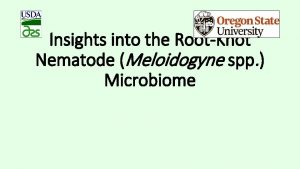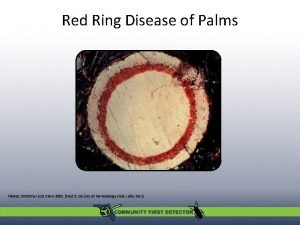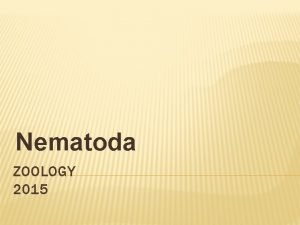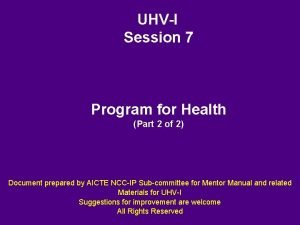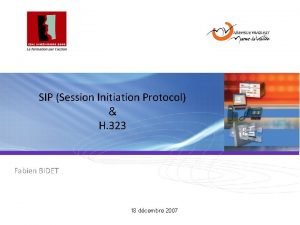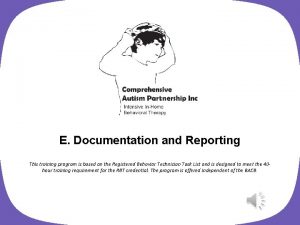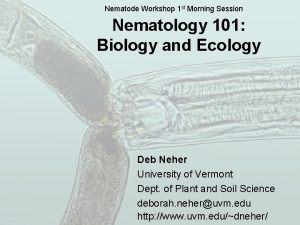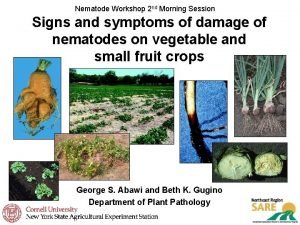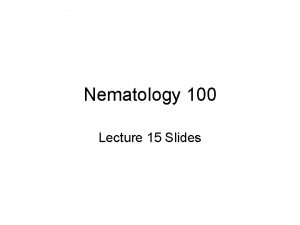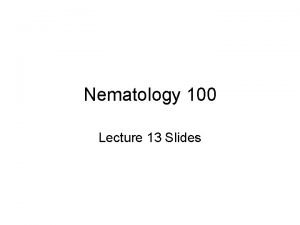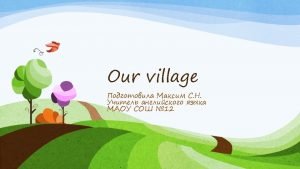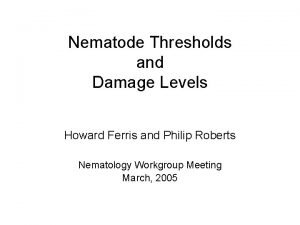Nematode Workshop 1 st Morning Session Nematology 101



























- Slides: 27

Nematode Workshop 1 st Morning Session Nematology 101: Biology and Ecology Deb Neher University of Vermont Dept. of Plant and Soil Science deborah. neher@uvm. edu http: //www. uvm. edu/~dneher/

Soil Biological Indicators Lab Dr. Deborah Neher uses soil nematode & microarthropods for monitoring soil quality and measuring progress of soil remediation (http: //www. uvm. edu/~dneher/)

Abundance of soil animals per square meter in European grassland

General characteristics of nematodes ü Aquatic ü Unsegmented ü Appendageless ü Transparent ü Bilaterally symmetrical ü Generally bisexual ü Vermiform roundworms ü Non-coelomate Meloidogyne hapla ü Biotrophs

Sensory organs ü No eyes, appendages or segmentation ü Mechanosensory ü Chemosensory Fig. 2. Spiral-shaped chemosensory organs called amphids in an anterior position of Achromadora sp. collected from soil of Jumbo Valley fen in Cherry County, Nebraska.

Phytonematode anatomy & morphology ü Well developed digestive & reproductive & sensory systems ü Lack circulatory & respiratory systems

Nematode identification Pratylenchus Xiphinema Criconemella

Physiological versatility ü Tolerate harsh habitats avoid interspecific competition and many environmental selection pressures ü Regulate uptake of O 2 between 100 to 5% ü Permeable, hydrostatic skeleton osmoregulation of Ca, Mg, K ü Tolerate p. H from 1. 6 to 11. 0 ü Temperatures from sub-zero to 60 C +

Survival Aphelenchus, anhydrobiosis

Head structures of soil nematodes a) bacterivore b) bacterivore c) bacterivore, predator d) Fungivore and/or herbivore e) omnivore f) herbivore g) herbivore h) predator

Predatory nematodes ü May feed on nematodes, protozoa, bacteria, etc Figure 5. Teeth of oral opening of predator Mylonchulus montanus (1000 x magnification), collected in soil with big blue stem in the Konza Prairie (96 W 35’ 39 N 05’) near Manhattan, Kansas. Photograph is provided courtesy of Peter Mullin/2000.

Bacterial-feeding nematodes ü Simple tubular mouthpart ü Elaborate cuticle around oral opening Figure 4. Cuticle ornamentation of oral opening of Acrobeles ctenocephalus (1000 x magnification), collected in soil with little bluestem (Andropogon scoparius) in the Konza Prairie (96 W 35’ 39 N 05’) near Manhattan, Kansas. Photograph is provided courtesy of Peter Mullin/2000. Paulo Vieira (Mactode publications)

Plant-parasitic nematodes ü Respond to CO 2 & root exudates ü Move few cm per day ü Probe with stylet ü Ecto-parasites ü Endo-parasites ü Lifecycle: 3 weeks (rootknot) to 2 yrs + (dagger) Figure 3. Variation in morphology of spear-like structure in oral opening a) male plant-parasite Hoplolaimus galeatus (1000 x magnification) collected from soil with big bluestem (Andropogon gerardii Vitman) in the Konza Prairie (96 W 35’ 39 N 05’) near Manhattan, Kansas, and b) female fungivore Enchodelus hopedorus (400 x magnification) collected from the summit of Long’s Peak, Colorado (105 W 35’ 40 N 16’). Photographs are provided courtesy of Peter Mullin/2000.

Plant-parasitic nematodes con’t ü Generalists or specialists ü Hosts range from 1 to 100’s ü All crop plants are susceptible to at least one nematode species ü Most are root parasites but species have adapted to parasitize most plant tissues ü More damage can be associated with coarser textured soils – sands (larger pore space)

Major impacts of nematodes ü Decomposition of organic matter and recycling of nutrients (soil food web)

Major impacts of nematodes ü Decomposition of organic matter and recycling of nutrients (soil food web) ü Biological control agents, esp. for insects ü Research biological models ü Diseases of animals and humans (heartworm, Trichinosis, hookworm, etc. ) ü Important plant pathogens

Other nematodes. . . ü Animal parasites – Human: Night blindness, Elephantiasis – Pets: Hookworm – Insects: biocontrol ü Caenorhabditis elegans – Model system – Studies of aging, neurology, ecotoxicology

Major impacts of nematodes ü Decomposition of organic matter and recycling of nutrients (soil food web) ü Biological control agents, esp. for insects ü Research biological models ü Diseases of animals and humans (heartworm, Trichinosis, hookworm, etc. ) ü Important plant pathogens

Morphology and relative size of major plant -parasitic nematodes Agrios

Types of Plant-Pathogenic Nematodes Ectoparasites: feed from outside the plant Migratory: moves, feeding from plant to plant (dagger) Sedentary: remains on same plant (spiral) Endoparasites: feed from inside the plant Migratory: moves within and feeds on tissues (lesion) Sedentary: remains within same plant and feeds at specialized sites (root-knot)

Sedentary ectoparasite (spiral) Migratory ectoparasite (dagger) Essential Plant Pathology, 2006 Sedentary endoparasite (root-knot) NC State Univ. Migratory endoparasite (lesion)

Typical lifecycle of a plant-parasitic nematode M M M H M

Meloidogyne hapla 3 rd stage juvenile 4 th stage juvenile Formation of giant cells and galls J 2 infect root Egg mass 2 nd stage juvenile (J 2) mobile in soil 1 st stage juvenile Egg Modified from Agrios, 1997

Lifecycle of Pratylenchus penetrans – Root-lesion nematode Agrios

Plant productivity losses Meloidogyne, Root knot nematode damage

How do nematodes damage plants? ü Direct feeding on plants (metabolic sinks) ü Malformation of host tissues (morphological & physiological) ü Predispose host plant to physical stress ü Provide entry for secondary pathogens (disease complexes) ü Breakdown of resistance to other pathogens ü Vectoring of plant pathogens (virus & bacteria) ü Suppression of beneficial organisms

Nematology 101: Biology and Ecology Questions? Coming up next. . . signs and symptoms
 Nematode
Nematode Botulus microporus
Botulus microporus Glblin
Glblin Annelida vs nematoda
Annelida vs nematoda Pinworms
Pinworms Nematode
Nematode Hello formal
Hello formal Teacher
Teacher Buenas tardes good afternoon
Buenas tardes good afternoon Nobody loves me poem
Nobody loves me poem Good morning, everybody
Good morning, everybody Good morning class!
Good morning class! Hello friend! i am glad to see you!
Hello friend! i am glad to see you! Brother john morning bells are ringing
Brother john morning bells are ringing Uhv session
Uhv session This session will be recorded
This session will be recorded Talk boost tracker
Talk boost tracker Nexthink servicenow integration
Nexthink servicenow integration Ucsd summer session
Ucsd summer session Bgp culling
Bgp culling Session initialisation protocol
Session initialisation protocol Session jo
Session jo Rbt session note example
Rbt session note example Emacs session
Emacs session Alpha kappa alpha information session
Alpha kappa alpha information session Jsf session scope
Jsf session scope Awareness session invitation
Awareness session invitation Hkn review session
Hkn review session
